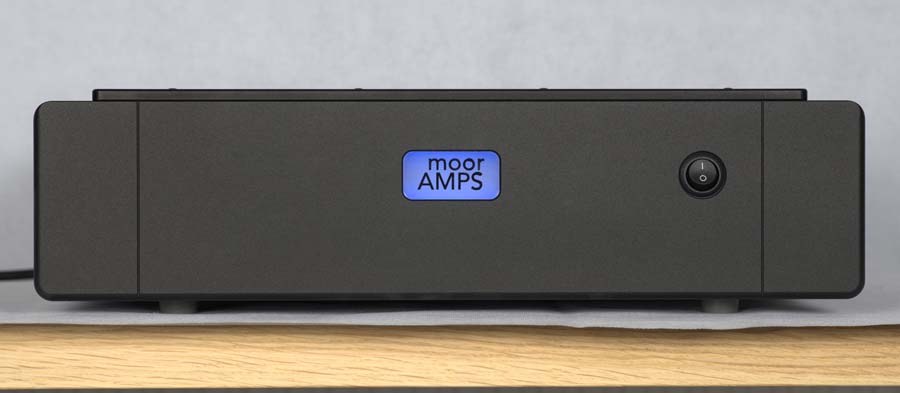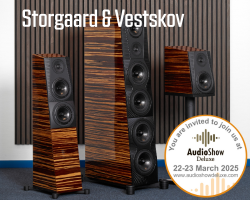MOOR AMPS ANGEL PRE AND ANGEL 4 POWER AMPLIFIER REVIEW
Moor Amps, based in Portland, Dorset, have earned a reputation for their meticulous design and UK-based manufacturing. The Angel Pre and Angel 4 Power Amplifier showcase this dedication to craftsmanship, with a focus on transparency, detail, and effortless musicality. Designed with 30 years of refinement, the Angel series combines robust build quality with top-tier performance, promising to deliver an elegant yet powerful addition to any HiFi setup. In this review, we put the Angel Pre and Angel 4 through their paces to see if they live up to their heavenly name.

I’m no stranger to Moor Amps, having first encountered them at a show a few years ago, where I spent considerable time chatting with the designer about his creations. Moor Amps is a small, specialist company based in Portland, Dorset, a picturesque area of the UK where I’ve enjoyed several holidays. The name Moor Amps is a clever play on the family name, Narramore. The company’s philosophy is to use local UK suppliers for all manufacturing processes, with all testing carried out in-house to ensure the highest possible quality control. While this approach may seem obvious, it is not always the case in the industry and does result in higher manufacturing costs. However, it ensures that quality is never compromised. During my retail days, it was evident that cutting costs often led to lower quality and increased returns—something neither retailers nor customers appreciate. I’m pleased to report that the Moor Angel Pre and Angel 4 Power Amplifier operated flawlessly throughout my review period.
Why are they called Angel? According to the designer, one evening, after a long day soldering boards, he powered up the units and played Angel by Willie and the Bandits. The sound was so magical that he had a eureka moment, cementing the name. The design itself has been 30 years in the making.
DESIGN AND BUILD
ANGEL PRE


The Angel Pre was designed for ultimate transparency and natural musical flow, with no added colouration. The result is a simple, passive audio design. Like any great preamp, its sole purpose is to amplify delicate low-level signals for the power amplifier driving the loudspeakers.
The preamp features a robust, CNC-machined aluminium remote control that’s reassuringly weighty—though beware of dropping it on bare feet! It’s minimalist in design, with just six buttons, and instils confidence in its reliability. This is a refreshing alternative to the cheap-feeling plastic remotes supplied by many manufacturers.
Internally, the preamp uses high-quality relays to maintain signal integrity and manage input and output selection. There are four line-level inputs, including one labelled “phono” (though it requires an external phono preamp). A G=1 unity gain switch allows integration with an A/V system, and there’s a tape loop monitor and mute switch. The Alps high-quality potentiometer used for volume control is motorised and ensures smooth, quiet operation, with parallel channels for longevity. The mute function is soft-ramped, with options for “quiet mute” (low-level sound) or “silent mute” (no sound), both programmable for user preference.
The rear of the preamp includes gold-plated RCA inputs and outputs, XLR balanced outputs, a tape loop, and an output for a dedicated headphone amp. A set of ground switches allows users to manage earthing arrangements to avoid earth loops. The build quality is substantial, with aluminium panels designed to dampen external vibrations.
ANGEL 4 POWER AMPLIFIER



The Angel 4 Power Amplifier takes a simpler approach, with an illuminated power logo window and a rocker switch on the front. The rear includes gold-plated multiway binding posts, RCA inputs, an IEC power socket, and a standby power control.
Built to the same exacting standards as the preamp, the Angel 4 uses top-quality components in a low-feedback design, ensuring high current delivery for effortless handling of musical peaks. The amplifier’s output transistors provide excellent control over connected loudspeakers, delivering a combination of finesse and raw power.
SOUND QUALITY
I tested the Moor Angel combination with two pairs of speakers: my resident Totem Arros and the Ophidian Audio Ffions, a new design launched at the Cranage show.
Jazz is a major part of my musical diet, so I started with Sign of the Times by Bob James. The Moor combination revealed the album’s superb production, allowing the music’s rhythm and flow to shine. It drew me into the music with clarity and emotion, without becoming overly analytical.
Moving to Andreas Vollenweider’s Quiet Places, the Angel Pre and Angel 4 opened up the soundstage, showcasing the interplay between harp, cello, and percussion. The cello’s resonance and emotional depth were particularly moving, with every note laid bare.
The funk-filled grooves of AWB by Average White Band were equally joyous. The amplifiers handled the tight bass lines, sizzling percussion, and raucous saxophone with aplomb, filling the room with energy and bringing a big smile to my face.
For rock, I turned to Cochise from Audioslave’s debut album. The Moor combination had no trouble keeping up with the high-energy performance, delivering punchy guitar riffs and powerful vocals. The Ffions, with their superior power handling, paired beautifully with the Angel 4 to deliver a controlled yet thrilling experience.
Finally, I indulged in Wish You Were Here by Pink Floyd. The amplifiers captured every nuance of the band’s performance, from crystal-clear vocals to the sublime guitar work of David Gilmour. Throughout my testing, the Moor Angel Pre and Angel 4 Power Amp remained unfazed, delivering elegance and sophistication across all genres.
QUIBBLES
While the Angel Pre and Angel 4 excel in performance, their plain appearance may not appeal to those seeking “audio jewellery.” The remote control, though well-made, occasionally struggled with responsiveness. Additionally, the lack of an onboard phono stage may disappoint vinyl enthusiasts, though a dedicated external phono stage is likely to outperform an onboard option at this price level.
CONCLUSION
Understated in design but exceptional in performance, the Moor Angel Pre and Angel 4 Power Amplifier deliver on their promise of high-quality sound at a realistic price. At nearly £10,000 for the pair, they aren’t cheap, but their build quality, thoughtful features, and superb sound justify the investment. For those needing more power, the Angel 6 Power Amp offers a step up, but for my smaller listening room, the Angel 4 proved more than sufficient.
Moor Amps have crafted an elegant solution that balances power and finesse, making the Angel Pre and Angel 4 a compelling choice for discerning audiophiles.
AT A GLANCE
Build Quality and Features:
Excellent solid build that will last a lifetime
The Angel Preamp covers most connection scenarios with its flexibility
Remote control is useful
Sound Quality:
Plenty of power on tap due to the instantaneous power on reserve allowing the sound to flourish
Ability to drive awkward low impedance loads don’t phase this design giving total control
The sound is graceful and refined, it’s not just a muscle amp
Value For Money:
As I stated earlier nearly £10.000 isn’t beer money but when you compare the competition the outlook is bright. There are many alternative brands from the UK and elsewhere, but the Moor Amps can hold their own in my experience and graced my listening room with some of the nicest sounds I’ve heard in a long time.
We Loved:
Ease of use and simple set-up
Fit and forget design allows the listener to focus on the sound which is superb
Solid build instils confidence in the product
We Didn’t Love So Much:
Plain appearance belies sublime sound quality
Elevator Pitch Review: A totally UK designed and built pre and power amplifier combination proving we can compete with the best. The 30-year pursuit of perfection was well worth the wait and shows Rome wasn’t built in a day. Plain looks are only skin deep, it’s what lies beneath that’s important. Moor Amps are here to stay and produce a rather Moreish sound. (I’ll get my coat and leave now !!)
PRICE
- Angel Pre: £2,995
- Angel 4 Power Amplifier: £5,995

Ian Ringstead
SUPPLIED SPECIFICATIONS
ANGEL PRE
Inputs
- 4 Line level passive inputs
- 1 G=1 (Unity Gain) inputs for use with AV systems
- 1 Tape loop monitor input
- Outputs
- L/R Outputs to power amp RCA single ended
- L/R Outputs to power amp XLR balanced
- Tape Loop output
- Line level output (e.g. Headphone amp out)
- Volume Control
- High quality ALPS volume control
- Motorised for use with remote control
- Soft mute with quiet or silent options
- Frequency Response
- 5Hz to 50kHz +/- 1dB
- Low power standby
- Standby power less than 0.5W
- 2 standby outputs to power amplifiers
- Measurements
- Pre-Amplifier dimensions:
- Width 430mm x Depth 260mm x Height 65mm
- Weight 3kg
- Packaged dimensions:
- Width 500mm x Depth 336mm x Height 120mm
- Weight 4kg
- Mains Power
- IEC inlet cable for 230V AC 50Hz mains
- Optional 115V AC 60Hz version available
- Power Consumption:
- Maximum 15VA
- Standby < 0.5W
ANGEL 4 POWER AMP
- Output Power
- 75W RMS per channel into 8 ohms
- 150W RMS per channel into 4 ohms
- Distortion
- (with typical loudspeaker load)
- THD: < 0.01%
- IMD: < 0.01%
- Loudspeaker Outputs
- Nominal: 4 ohms to 16 ohms
- Connections: Wired, Spade or 4mm plug
- Inputs
- RCA (phono) inputs:
- 1V rms for full output
- Input Impedance 15k ohm
- Frequency Response
- 5Hz to 50kHz +/- 1dB
- Protections
- Short Circuit or Overload: +/-15A max
- Overtemperature: +55C
- Under temperature: +5C
- Measurements
- Amplifier dimensions:
- Width 430mm x Depth 340mm x Height 120mm
- Weight 16kg
- Packaged dimensions:
- Width 490mm x Depth 420mm x Height 170mm
- Weight 18kg
- Mains Power
- IEC inlet cable for 230V AC 50Hz mains
- Optional 115V AC 60Hz version available
- Power Consumption:
- Maximum 650VA
- Idle 50VA
- Standby < 0.5W
























































































































































































